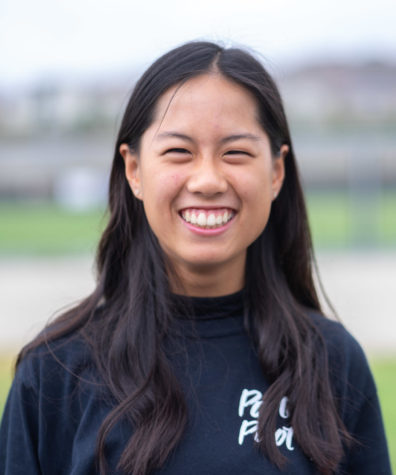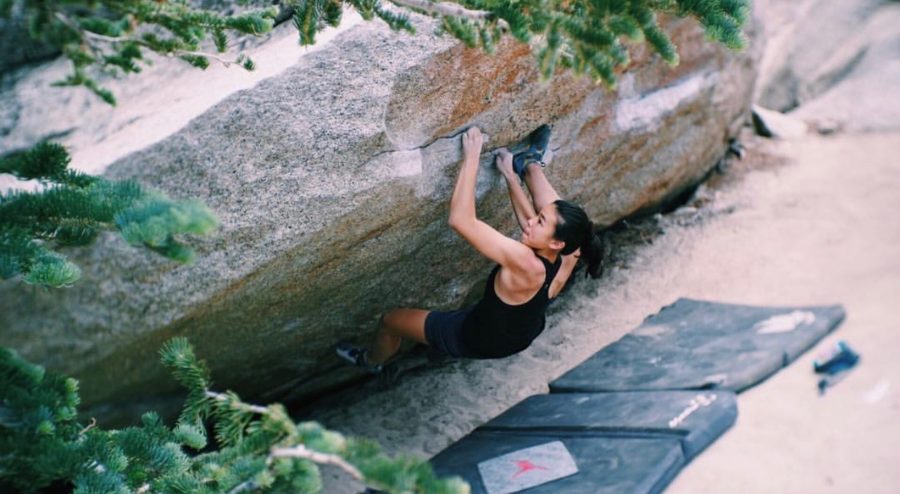Rock Climbers Ground Up For Competition
Courtesy of Sender One Climbing Team
Sophomore Phoebe Yun practices bouldering, a type of climbing that requires immense physical strength to complete a routine on a boulder close to the ground without any harnesses or ropes
With sweaty palms and quavering arms, the rock climber focuses on the next move to progress up the wall, while maintaining focus at the top: the finish button. While rock climbing may seem to be a popular one-time activity at a festival, there are numerous athletes who train almost every day in this new Olympic sport, including sophomore Phoebe Yun and junior Eaden Haresco, who both are active competitive rock climbers.
“My younger brother started climbing before me. One day, he forced me to climb at the gym; turns out it was super fun, and the community there was super welcoming,” Yun said. “I would hope by college I would be able to compete in open [professional] nationals or even maybe a World Cup.”
The climbers compete in bouldering, speed climbing and lead climbing. Bouldering requires athletes to climb as much of a 4 meter wall in four minutes. Speed climbing, competed between two athletes, consists of a climb 15 meters tall angled at 95 degrees. Lead climbing, the third event, allows climbers six minutes to climb as much of a wall taller than 15 meters.
“It is my way to relax from school as well as training for the other sports I play,” Haresco said. “Rock climbing can be a somewhat solo sport, but I see it as challenge against myself. Yeah you compete against other people, but there is only one person on the wall.”
Yun has only been climbing for a year and has competed in events including bouldering and speed climbing, along with qualifying for nationals in speed climbing. Haresco has been climbing for three years, but was unfortunately injured during the qualifiers last year. Both Yun and Haresco have been nationally ranked in the youth league, but Haresco recently turned 17, moving him up into a new division. He has been unable to continue with intense rock climbing training after his injury but continues to attend gym competitions, contests that offer prizes such as memberships or climbing gear without losing their national rankings.
Haresco currently trains with Aesthetics Climbing Gym while Yun currently trains with Sender One Climbing Team. Climbers typically practice in the fall and winter for bouldering season in preparation for the regional, divisional and national competitions taking place in December, January and February. At the end of this competition season, climbers go immediately into sport and speed season, which ends in summer.
“Even though all of us are against each other at competitions, the entire community of climbers is really welcoming,” Haresco said. “At my first competition, I got absolutely destroyed, but I learned a lot from the other competitors.”
For both athletes, climbing has become an integral part of their lives, a sport that requires immense strength and flexibility both physically and mentally. While this sport is seen to be dangerous, it has proved to be rewarding for both Yun and Haresco.
“It doesn’t take much to be a climber, it’s more so about the time you put into being a climber. The training needed for competing nationally takes a lot of time,” coach Trevor Arndt said. “You need to build up stamina, muscle and all-around experience with climbing.”
For the 2020 summer olympics in Tokyo, climbing will also be included, introduced in the form of three climbing events: bouldering, speed climbing and lead climbing. Scores from all three climbs will be assessed and added up to determine the first Olympians in this sport.
“Climbing for me is just something I can’t be away for long I guess,” Yun said. “There are always different ways to do a route, and it depends on the person and your creativity as well as how long you are willing to keep at it and learn from your mistakes to find the best way to do the climb for yourself. It’s really rewarding, and even though you don’t technically finish the climb, you still learn a lot, and it really motivates me to train hard.”
Your donation will support the student journalists of Portola High School. Your contribution will allow us to purchase equipment and cover our annual website hosting costs.

Julia Kim is your 2019-20 Opinion Editor, continuing her fourth - and last - year on the Pilot! Outside of journalism, you can find her at the dance studio,...




